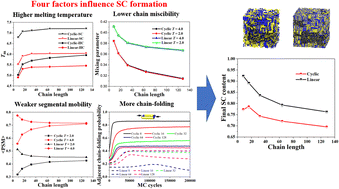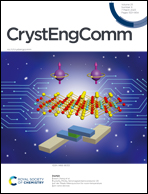Stereocomplex crystallization in cyclic polymer blends studied using dynamic Monte Carlo simulations†
Abstract
Due to the absence of chain ends, cyclic polymers exhibit different crystallization behaviours from linear polymers. In the current work, the dynamic Monte Carlo simulation method was used to explore stereocomplex crystallization in cyclic polymer blends. Compared with linear polymer blends, the cyclic polymer blends have lower final contents of stereocomplex crystallites (SCs). This decline in the stereocomplexation ability can be attributed to the discrepancy in four factors (melting temperature, chain miscibility, segmental mobility and crystallization mode). The cyclic polymer blends exhibit higher melting temperature, lower miscibility, weaker segmental mobility and higher fraction of chain-folding, leading to the formation of less SCs. In addition, the final SC contents decrease with the increase of chain length of the cyclic polymers, except the system with a chain length of 16 lattice sites, which has higher final SC contents compared with the system with a chain length of 8 lattice sites at high temperatures. This abnormal phenomenon is caused by the improvement of segmental mobility in the systems with longer chains that have weaker movement correlations between different segments.



 Please wait while we load your content...
Please wait while we load your content...